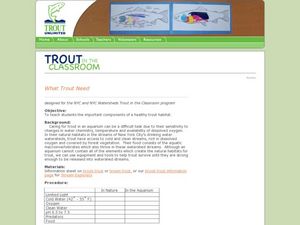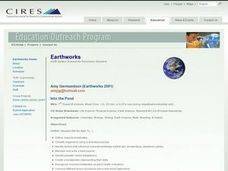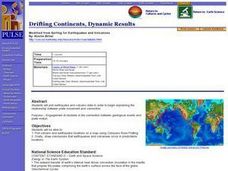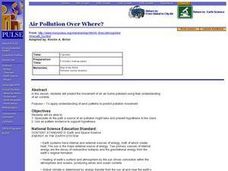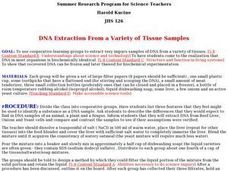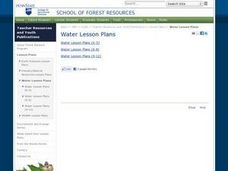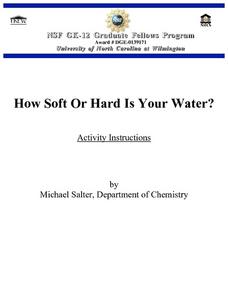Curated OER
What Trout Need
Students investigate the important components for a healthy trout habitat. In this fish habitat lesson, students discuss how the aquarium will simulate a trout's environment in nature. Students complete a trout information sheet to set...
Curated OER
Into the Pond
Seventh graders use a pond to explore macroinvertebrates and other organisms. They use a dichotomous key to classify the organisms and maintain a journal recording their findings.
Curated OER
Structure of the Earth System
Eighth graders describe the steps in the water cycle. They discuss factors that affect runoff and explain the differences between stalactites and stalagmites. They discover the importance of ground water.
Curated OER
Drifting Continents, Dynamic Results
Students plot earthquake and volcano data using a Compass Rose Plotting. They explain the relationship between plate movement and connection. They draw conclusions that earthquakes and volcanoes occur in predictable locations.
Curated OER
Fallout!
Students plot the locations of fallout from two disasters that polluted much of the world's air. They plot the ash fallout from the 1980 Mt. St. Helen's eruption to see what the wind patterns in the United States look like overall. Next...
Curated OER
Air Pollution Over Where?
Young scholars predict the movement of an air borne pollutant using their understanding of air currents. They determine which governments and/or communities should be contacted to be forewarned. They also explore the properties of their...
Curated OER
Growing Crystals
Students are introduction to the cause and effect of a chemical reaction between water, mucilage glue, and magnesium sulfate as they form crystals.
Curated OER
DNA Extraction From a Variety of Tissue Samples
Students, working in cooperative groups, extract very impure samples of DNA from a number of tissue samples. They determine how the samples can be preserved and how they are similar.
Curated OER
Color Burst
Students gain experience in asking questions and conducting inquiry by exploring the separation of colors in water and other solvents; to communicate and share findings of student investigations.
Curated OER
Fresh Water From the Oceans?
Students participate in an activity in which they demonstrate how the evaporations of water from the oceans results in fresh water in the form of rain. They create a saltwater solution in a flask and boil the water until most of the...
Curated OER
Yellow Pod
Students use appropriate skills to design and conduct scientific investigation. They sort and classify various ingredients and analyze their investigation. Finally, students describe the observable states of matter, bot solids and liquids.
Curated OER
Losing An Island
Students examine carbon dioxide and determine the impact of greenhouse gases on the earths spheres. In this pollution lesson students complete a lab activity to see the impact of gases on the environment,
Curated OER
Exploring With Photograms
Students observe the interaction between energy absorbed, reflected or transmitted through an object in a photochemical process with a classroom demonstration.
Curated OER
"Pennsylvania Watersheds, Many Ways to the Sea"
Students trace a molecule of water through the water cycle including each of its three loops. They describe why evapotranspiration demands the largest portion of total precipitation falling on a forested watershed.
Curated OER
Why is the Sea Salty?
Students conduct a hands-on activity to investigate salt concentrations in water and how salt remain after water evaporates. They can also do a Saltwater Painting to once again observe the evaporation. process.
Curated OER
Organic Materials in an Aquatic Ecosystem
Young scholars evaluate the relationship between oxygen levels and the amount of organic matter in an aquatic ecosystem. They explain the relationship between oxygen levels, bacteria and the breakdown of organic matter using an indicator...
Curated OER
Water Quality Comparison of Pulpit Rock Stream and Welton Falls
Eighth graders analyze different water samples given to them by their teacher.
Curated OER
How Soft or Hard is Your Water?
Students test samples of water to determine how a chemical water softener affects water's ability to form suds. After collecting their data and analyzing their results, students answer follow-up questions about their lab.
Curated OER
Underwater Picture of the Hudson River Estuary
Students identify important aspects of water quality such as slainity and turbidity. They test two of the water quality parameters and determine the quality of the water. In addition, they construct two sets of graphs based on data...
Curated OER
Kidney and Related Concepts
In this kidneys worksheet, students review the function of the kidneys including what happens when the kidneys stop working. Students also compare kidney function in fish, frogs, and kangaroo rats. This worksheet has 86 fill in the blank...
Curated OER
Mussel Your Way Through Photosynthesis
Pupils, using zebra mussels (Dreissena polymorpha), elodea and an indicator dye, observe and record the role of light in photosynthesis. They consider plant production of carbon dioxide and the use of live materials in biological research.
Curated OER
An Underwater Sediment Slide?
Students explore the proximity of the Hudson Shelf Valley and the Hudson Canyon to one of the Nation's most populated areas. They study that from 1987 to 1992, two dumpsites in the Hudson Shelf Valley and Hudson Canyon, one 12 miles
Curated OER
Rusting: A Form of Oxidation
Students observe and record the corrosive nature of oxidation-reduction reactions, and determine the electro-chemical series of selected metals.
Curated OER
It's the Slime Time
Students experiment to understand the basic concept of polymerization and to understand the dissolution theory. Student experiment with polymers to understand its behavior and the mechanical behavior of polymer networks.


